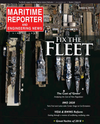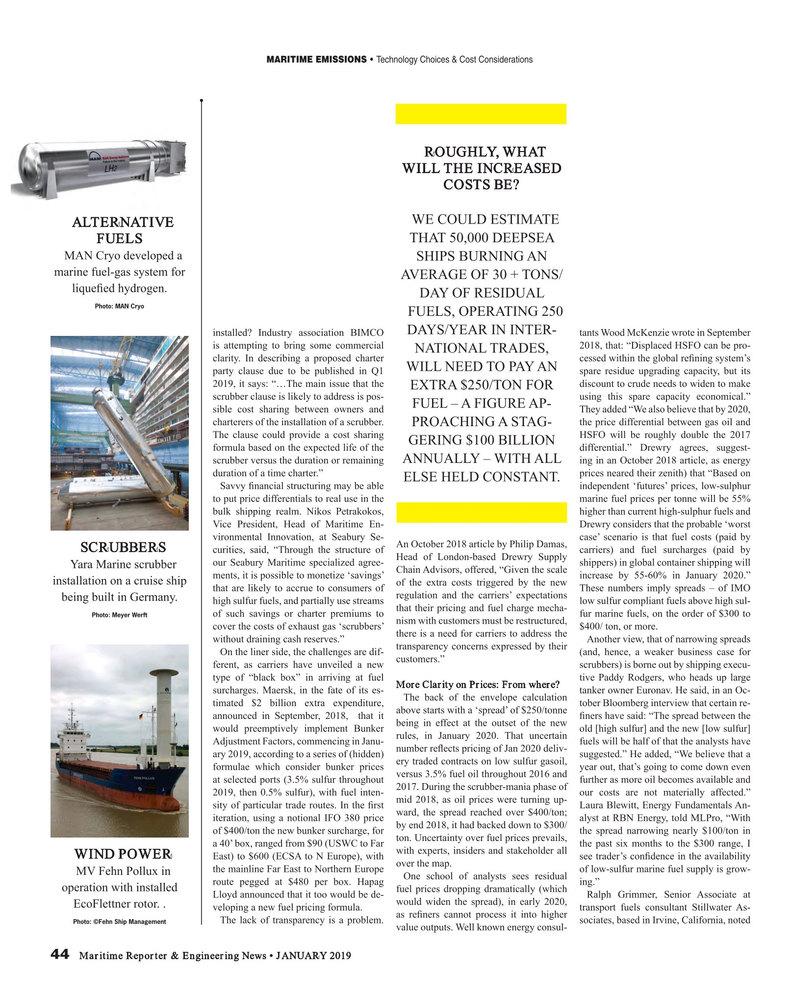
Page 44: of Maritime Reporter Magazine (January 2019)
Ship Repair & Conversion: The Shipyards
Read this page in Pdf, Flash or Html5 edition of January 2019 Maritime Reporter Magazine
MARITIME EMISSIONS • Technology Choices & Cost Considerations
ROUGHLY, WHAT
WILL THE INCREASED
COSTS BE?
WE COULD ESTIMATE
ALTERNATIVE
FUELS THAT 50,000 DEEPSEA
MAN Cryo developed a
SHIPS BURNING AN marine fuel-gas system for
AVERAGE OF 30 + TONS/ lique? ed hydrogen.
DAY OF RESIDUAL
Photo: MAN Cryo
FUELS, OPERATING 250
DAYS/YEAR IN INTER- installed? Industry association BIMCO tants Wood McKenzie wrote in September is attempting to bring some commercial 2018, that: “Displaced HSFO can be pro-
NATIONAL TRADES, clarity. In describing a proposed charter cessed within the global re? ning system’s
WILL NEED TO PAY AN party clause due to be published in Q1 spare residue upgrading capacity, but its 2019, it says: “…The main issue that the discount to crude needs to widen to make
EXTRA $250/TON FOR scrubber clause is likely to address is pos- using this spare capacity economical.”
FUEL – A FIGURE AP- sible cost sharing between owners and They added “We also believe that by 2020, charterers of the installation of a scrubber. the price differential between gas oil and
PROACHING A STAG-
The clause could provide a cost sharing HSFO will be roughly double the 2017
GERING $100 BILLION formula based on the expected life of the differential.” Drewry agrees, suggest-
ANNUALLY – WITH ALL scrubber versus the duration or remaining ing in an October 2018 article, as energy duration of a time charter.” prices neared their zenith) that “Based on
ELSE HELD CONSTANT.
Savvy ? nancial structuring may be able independent ‘futures’ prices, low-sulphur to put price differentials to real use in the marine fuel prices per tonne will be 55% bulk shipping realm. Nikos Petrakokos, higher than current high-sulphur fuels and
Vice President, Head of Maritime En- Drewry considers that the probable ‘worst vironmental Innovation, at Seabury Se- case’ scenario is that fuel costs (paid by
SCRUBBERS curities, said, “Through the structure of An October 2018 article by Philip Damas,
Head of London-based Drewry Supply carriers) and fuel surcharges (paid by our Seabury Maritime specialized agree- shippers) in global container shipping will
Yara Marine scrubber
Chain Advisors, offered, “Given the scale ments, it is possible to monetize ‘savings’ increase by 55-60% in January 2020.” installation on a cruise ship that are likely to accrue to consumers of of the extra costs triggered by the new These numbers imply spreads – of IMO being built in Germany.
high sulfur fuels, and partially use streams regulation and the carriers’ expectations low sulfur compliant fuels above high sul- of such savings or charter premiums to that their pricing and fuel charge mecha- fur marine fuels, on the order of $300 to
Photo: Meyer Werft nism with customers must be restructured, cover the costs of exhaust gas ‘scrubbers’ $400/ ton, or more.
there is a need for carriers to address the without draining cash reserves.” Another view, that of narrowing spreads transparency concerns expressed by their
On the liner side, the challenges are dif- (and, hence, a weaker business case for ferent, as carriers have unveiled a new customers.” scrubbers) is borne out by shipping execu- type of “black box” in arriving at fuel More Clarity on Prices: From where?
tive Paddy Rodgers, who heads up large surcharges. Maersk, in the fate of its es- The back of the envelope calculation tanker owner Euronav. He said, in an Oc- timated $2 billion extra expenditure, above starts with a ‘spread’ of $250/tonne tober Bloomberg interview that certain re- announced in September, 2018, that it ? ners have said: “The spread between the would preemptively implement Bunker being in effect at the outset of the new old [high sulfur] and the new [low sulfur]
Adjustment Factors, commencing in Janu- rules, in January 2020. That uncertain fuels will be half of that the analysts have number re? ects pricing of Jan 2020 deliv- ary 2019, according to a series of (hidden) suggested.” He added, “We believe that a formulae which consider bunker prices ery traded contracts on low sulfur gasoil, year out, that’s going to come down even versus 3.5% fuel oil throughout 2016 and at selected ports (3.5% sulfur throughout further as more oil becomes available and 2017. During the scrubber-mania phase of 2019, then 0.5% sulfur), with fuel inten- our costs are not materially affected.” mid 2018, as oil prices were turning up- sity of particular trade routes. In the ? rst Laura Blewitt, Energy Fundamentals An- iteration, using a notional IFO 380 price ward, the spread reached over $400/ton; alyst at RBN Energy, told MLPro, “With by end 2018, it had backed down to $300/ of $400/ton the new bunker surcharge, for the spread narrowing nearly $100/ton in ton. Uncertainty over fuel prices prevails, a 40’ box, ranged from $90 (USWC to Far the past six months to the $300 range, I with experts, insiders and stakeholder all
WIND POWER
East) to $600 (ECSA to N Europe), with see trader’s con? dence in the availability over the map. the mainline Far East to Northern Europe One school of analysts sees residual of low-sulfur marine fuel supply is grow-
MV Fehn Pollux in route pegged at $480 per box. Hapag fuel prices dropping dramatically (which ing.” operation with installed
Lloyd announced that it too would be de- Ralph Grimmer, Senior Associate at
EcoFlettner rotor. .
veloping a new fuel pricing formula. would widen the spread), in early 2020, transport fuels consultant Stillwater As-
The lack of transparency is a problem. as re? ners cannot process it into higher sociates, based in Irvine, California, noted
Photo: ©Fehn Ship Management value outputs. Well known energy consul- 44 Maritime Reporter & Engineering News • JANUARY 2019
MR #1 (42-49).indd 44 MR #1 (42-49).indd 44 1/14/2019 11:09:54 AM1/14/2019 11:09:54 AM

 43
43

 45
45
